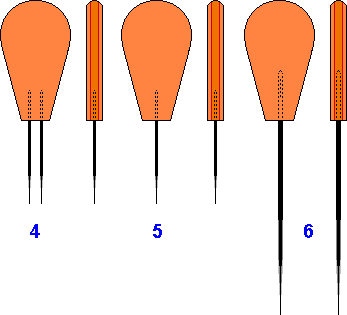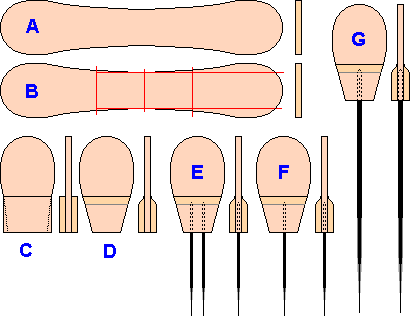Slide Masks & Spacers
|
|
|
|---|
|
Slide Masks & Spacers |
Microscopy Tools... Mounted Needles |
|---|
Mounted Needles of one type or another are very useful in microscopy and dissection. They are simply made and the materials are inexpensive. Ordinary sewing needles are readily available in a wide variety of lengths and thickness.
The Type 2 single needle has a round handle, but may benefit from having a small flat planed or sanded on it to stop it rolling off the desk. The type 3 twin needle version is shown here with a reduced flat handle... I find this gives more control and lets me feel what is happening. The lengths are not critical... Use what you find comfortable. I varnish mine so that they are more easily washed. |
Types for clumsy fingers
I have problems... The type 6 item on extreme right works well, but the types 4 and 5 seem to be somewhat "handle heavy". I tend to hoard odd bits of wood, but apart from some very thin aeromodelling ply I had nothing suitable... However I found the beech lollipop stick that is illustrated in the drawing below right (type A). |

|
|---|
|
The lollipop stick is 2 mm thick which is ideal for the paddle itself, but not thick enough to accept the needles so I cut it in the fashion denoted by the red lines shown at "B". The smaller pieces were laminated "cross grain" onto the paddle, using waterproof PVA glue, and clamping firmly in a vice overnight. (Diagram "C") The shape depicted in diagram "D" was fashioned using a "Dremel" tool fitted with a 15 mm sanding drum. The finished articles are illustrated as types "E", "F" and "G". |

|
|---|
The needles are fixed into the handles by first drilling a pilot hole that is 90% of the diameter of the needle being used. Then a blob of cyanoacrylate glue (superglue) is placed on the end of the handle and the needle is forced into position using pliers to grip the needle.
Alternatively the needle can be held, point down, in the jaws of a vice and the handle, with blob of superglue, tapped onto the protruding "eye" end.
These mounted needles may be used for dissection, fixing specimens to blocks, Placing wings on adhesive strips during Wing Mounting and other tasks.
If a cutting action is required, then "Diabetic" syringes may be used as the integral needle is sharpened to a cutting edge at it's tip and the plastic barrel acts as a handle.
The Plywood and lollipop stick versions may be lightened further by drilling holes (the edges of the holes may provide extra purchase as the soft tips of thumb and forefinger will deform into the holes due to the gripping pressure).
Written... Summer 2000, Revised... 09 September 2001, Upgraded... 07 December 2004, Further Upgraded... 12 January 2007,
|